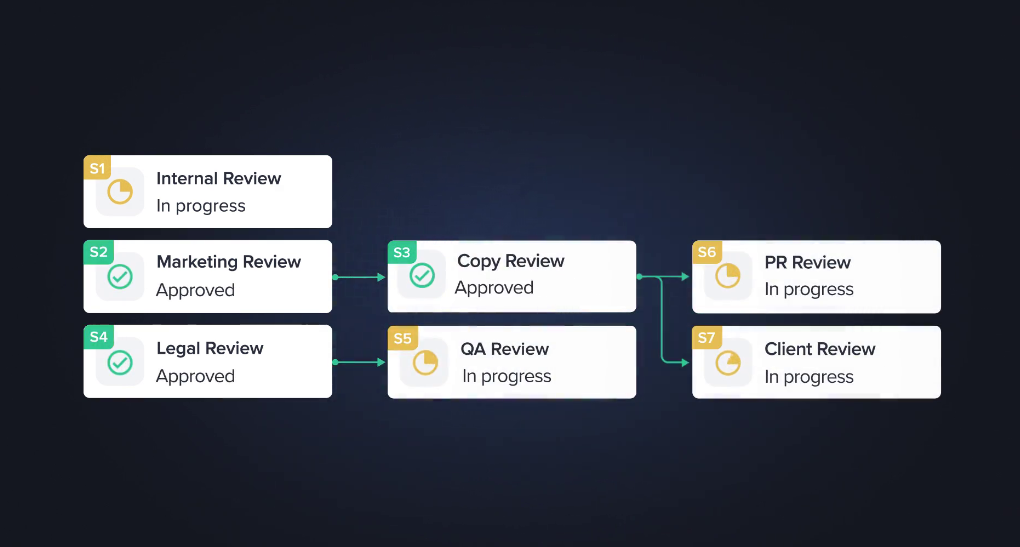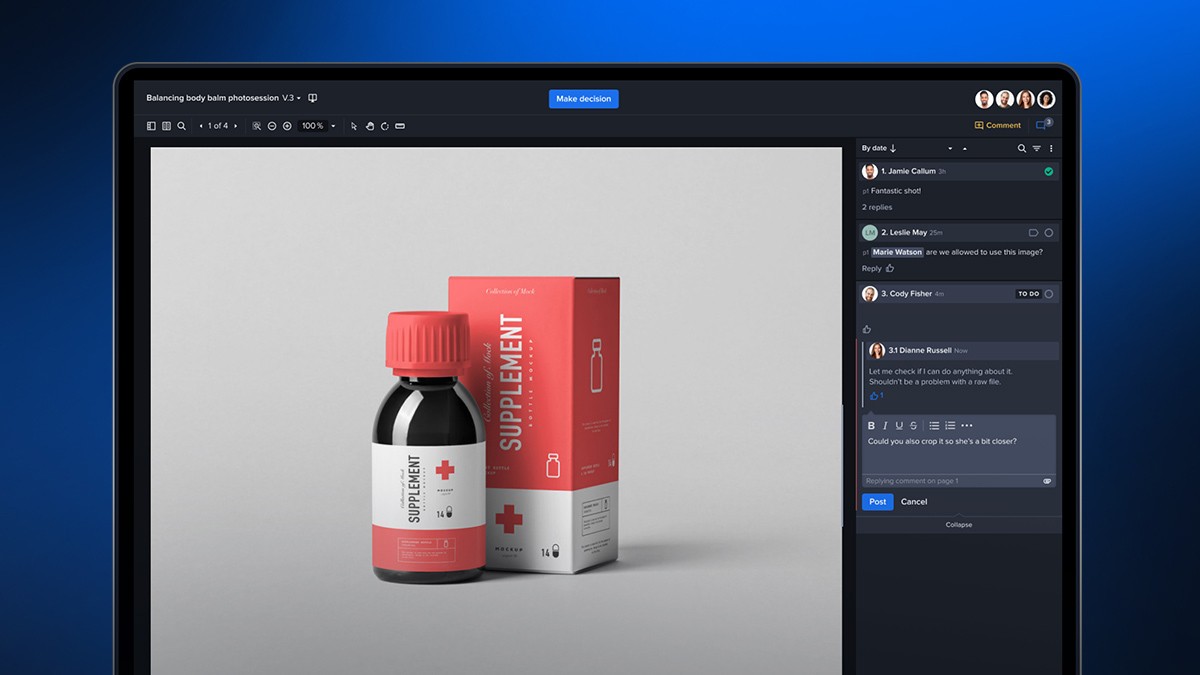In the halls of uncelebrated marketing jobs, the compliance officer gets a special shrine. Performing the job perfectly means never being noticed, and overlooked errors can send tremors through not only the creative team, but the organization as a whole. Let’s dive into some of the challenges compliance officers face when working with creative teams, and how you can run a tighter ship when reviewing and approving marketing content.
What we'll cover
Table of contents
Marketing compliance: the unsung foundation of creative work
At Ziflow, our lifeblood is exceptional creative. We relentlessly search for methods to improve processes and clear the bureaucratic debris for creatives so that they can focus on delivering stunning work.
Even the most eye-grabbing, business-driving creative must be compliant from a branding and legal standpoint. Before work is fit for the outside world, it must pass through a legal and compliance review. Cue the compliance officer.
What does “great” creative mean to a marketing compliance officer? It’s not just perfect proportions or a clever tag-line. To these crucial gate-keepers, marketing and product content must:
- Serve the needs of the client/consumer
- Make sense to the consumer
- Accurately describe products and services
- Maintain brand consistency across all mediums
- Avoid violating industry regulations for claims and advertising
When evaluating design, usually there are no “wrong” answers — color palettes, visual composition, and other elements are based on feeling and preference. For a compliance officer, this couldn’t be further from the truth. There are wrong answers to compliance questions, and ultimately, the brand risk falls on their shoulders. If you want a scary read, check out the outcomes of poor marketing compliance.
When you think about it, a marketing compliance officer has to be half creative reviewer, half no-nonsense lawyer. They must be the bridge between great creative and legal practicalities. Not an easy task.
Ongoing challenges for compliance officers working with creative teams
Marketing compliance officers (sometimes called legal officers, among other titles) work lockstep with the creative team during the creative process, however the work they perform and the things they’re keeping an eye on are vastly different.
You’ve got to balance design with due diligence
The absolute last thing a marketing team thinks about when they’re in the trenches developing great creative to appease impatient clients (and managers) is potential compliance conflicts. Your marketing and design team keep up with the latest aesthetic trends, not legal regulations. This is where the compliance officer steps in.
It’s your responsibility to know both brand standards and regulatory compliance, and to speak up when your team isn’t following them. This may seem like a “bad cop” role in the creative development process, but if you’re open and transparent with your team, they’ll understand that you’re there to protect their positions and the company.
You’re now monitoring several channels and content types
Keeping an eye on a single channel and content type is a full-time job for most people. But compliance officers have to be wired differently, and ensure consistency across:
- Internal communications
- Consumer communications
- Product packaging and design
- Digital content & video
- Social media
- Real-time/personalized content
- Native ads
On top of needing eyes on the back, sides and top of your head, regulations for these channels and content types are constantly changing (and are often ill-defined or mirky) as digital marketing continues to evolve.
You’re not always on the front lines of the creative process
Compliance officers usually see work-in-progress creative (when they have the time or bandwidth) in the later stages of marketing production. There’s never a doubt that you’re a stakeholder for the creative team and the final line of approval for marketing materials, but you’re also pulled in multiple directions. It’s not possible to always be in the loop, or act as an owner of projects.
It’s tough to create a history of approvals
When you’re not in charge of a marketing project (or even there at the start of the process) it’s nearly impossible to follow the zig-zag history of work and approvals. How many times have you opened a creative email thread, seen the endless replies, and wanted to hide?
When a problem manifests, sifting through emails and chats to find who approved something and at what time is a nightmare. It’s a waste of your time.
In addition to being legal and creative gurus, marketing compliance officers must also be technologists and part-time human factors specialists who can develop easy-to-understand processes to track content production.
Tips for improving compliance review of marketing content
So, you’ve put on your creative and legal hats, dabbled in technology and workflow processes, and given someone the bad news that their creative has run afoul of compliance regulations. Here’s how to improve your working relationship with them:
Collaborate on brand standards and toolkits
Nip potential compliance problems in the bud by collaborating early on with the marketing team and designers regarding brand management. Most marketing and creative teams have a brand playbook (also called a brand bible or brand deck) that spells out everything from color palettes, brand voice, fonts, spacing, and the dos and don’ts of content creation. Your input needs to be embedded in this guide so that compliance is a consideration from the word “go.”
It’s a plug-and-play solution for creating content that stakeholders and creatives alike can always reference when they need to.
Formalize compliance review stages
Don’t leave the structure of your compliance review stages ambiguous. Discuss early on which stages of the creative process you’d like to see work. Maybe you have a more junior team, or are working on projects where compliance is very meticulous, and you need to see creative briefs before copy and design even begins so that you know it’s on the right track. And do you need to provide feedback on different elements as they are developed, or do you just need to put a stamp of approval on content before it goes out the door?

And just as crucial is discussing realistic turnaround times for review. There’s nothing worse than being an unexpected bottleneck, so don’t be afraid to be open and honest about what you’ll need timewise. Similarly, discuss when you’ll expect revisions from the team.
Creative relationships won’t sour if there’s a predictable working cadence and expectations set from the beginning. And if they need to change for any reason, prompt communication is key.
Creative workflow solutions for compliance can help automate these review stages and ensure work doesn't progress until the proper sign-off has occurred.
Keep track of comments and approvals in one place
We can’t stress this enough — you need a system in place to track changes and content over the life of a project to clearly show who signed off on decisions and creative work. A sign-off system that captures feedback and approvals beyond disparate project management, email, and shared file drives will more accurately capture the full scope of creative approval and production. You’ll save a lot of headaches, and if you’re audited for any reason, you’ll save time.

Apply digital signatures to creative content
The ultimate accountability tool in creative review is digital signatures. The perception of signatures is that they only apply to formal or legal documents. Not so. When you use digital signatures to formally track feedback and approval in the creative process, you create a clear map of responsible stakeholders from start to finish.
Yes, the marketing compliance officer role is an unsung position, but hopefully you can see that it’s a deeply fulfilling one when a solid creative feedback process is implemented. By using some of the tips mentioned above, you can bridge the spaces between legal compliance, brand integrity, and exquisite creative—all while staying in the good graces of your creative team.
→ For more insight on how to manage a comprehensive compliance review process with your creative team, check out our eBook: "The Ultimate Guide to Marketing Compliance."



